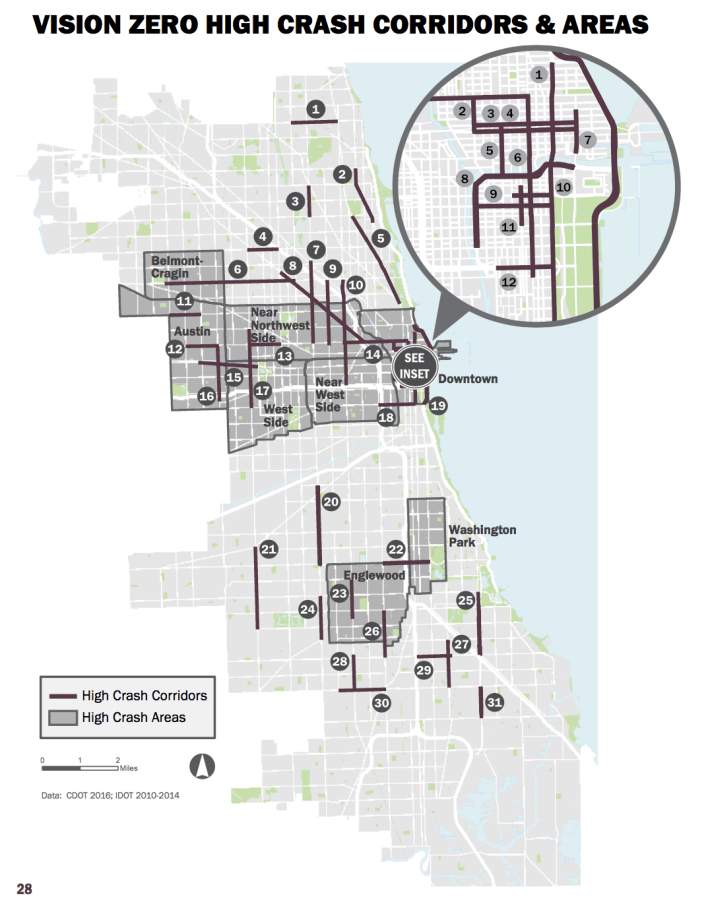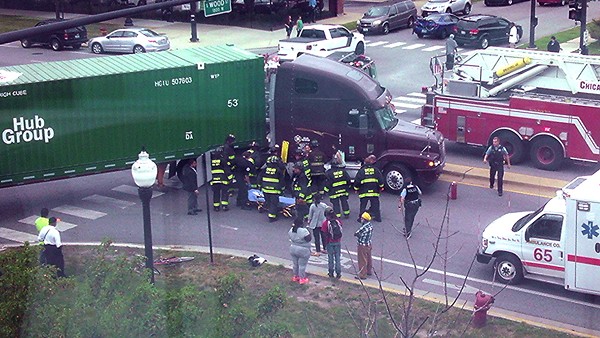Back in September 2016, when the city of Chicago announced it would finally be releasing a formal, data-driven, interdepartmental Vision Zero plan to eliminate traffic deaths and serious injuries by 2026, Streetblog’s headline was “Better Late Than Never.” After all peer cities like New York have had Vision Zero plans for years, so we’ve got some catching up to do.
At the time, Mayor Rahm Emanuel’s office said Chicago would be releasing a three-year Vision Zero Action Plan later that fall. Nine months later, the city has finally released the action plan, which was written with input from a dozen departments and agencies. Due to the delay, I’m temped to recycle that headline. But the important thing is that Chicago is finally getting moving on this crucial mission to reduce the carnage on our streets, where currently dozens of people are injured in crashes every day, and more than 100 people are killed in collisions each year.
Download the full Vision Zero Action Plan here.
“Chicago has made progress in making our streets safer, but we still experience far too many traffic crashes,” Emanuel said in a statement. “The status quo is unacceptable,” Mayor Emanuel said. “We will streamline our efforts to protect the lives, health and well-being of all Chicagoans.”
Emanuel announced the plan’s release this afternoon along with 37th Ward alderman Emma Mitts by a pedestrian refuge island recently installed at Chicago Avenue and Lamon Avenue as a part of a Safe Routes to School infrastructure project. “I am happy that Mayor Emanuel launched the Vision Zero Action plan in the 37th Ward,” Mitts said in a statement. “We will do everything we can to spread the message of Vision Zero and save lives.”
As part of part of the development of the action plan, the following departments and agencies have been involved in discussions with local leaders, community organizations, and residents:
- Office of the Mayor
- Chicago Department of Transportation
- Chicago Department of Public Health
- Chicago Police Department
- Chicago Transit Authority
- Department of Business Affairs and Consumer Protection
- Department of Cultural Affairs and Special Events
- Office of Emergency Management and Communication
- Department of Fleet and Facility Management
- Chicago Fire Department
- Department of Innovation and Technology
- Chicago Public Schools
The planning process was coordinated by the Mayor’s Office and led by CDOT and the health and police departments. “Vision Zero Chicago is not a top down city initiative, but a starting point for a broad partnership that will tackle the public health crisis that affects the lives and wellbeing of Chicagoans every single day,” transportation commissioner Rebekah Scheinfeld said in a statement. “The Vision Zero Action Plan identifies city resources and spells out detailed strategies for how we are going to work with stakeholders to achieve the ultimate goal of saving lives and eliminating serious and fatal traffic crashes.”
A news release for the plan noted that more than 2,000 people are killed or seriously injured in crashes in Chicago each year, with an average of five people seriously injured each day and one person killed every three days.
As part of developing the Vision Zero Chicago plan, the city used crash data to identify 43 High Crash Corridors and eight High Crash Areas. Of the High Crash Areas, seven of the eight are on the West and South sides of the city, with the rest being downtown, which the city attributes to the high volume of pedestrians and vehicles. The data also shows that people who live in areas of high economic hardship are three times as likely to die as a result of a traffic crash.
As I’ve discussed before, since the Vision Zero efforts will be focused on these High Crash Areas, which are largely lower-income communities of color, it’s important that any increase in traffic enforcement be done in an equitable way. For example, in March a Chicago Tribune investigation revealed apparent bias in the police department’s ticketing for bike infractions, with an overwhelming number of the citations being written in African-American community areas.

It’s going to be crucial for residents of the High Crash Areas to have a say in what kind, how much, and where the increased enforcement should be implemented. The CPD also needs to be held accountable for doing any additional ticketing in a fair manner, and not using traffic stops as an excuse for otherwise-unconstitutional “stop-and-frisk” policing.
For what it’s worth, the city is promising to keep equity at the forefront of the safety initiative. “While enforcement is an important and effective tool in preventing dangerous driving behaviors, CPD will work in partnership with communities and residents to ensure that all traffic safety interventions are fair and focused appropriately,” the news release stated.
"Achieving the goals that are part of the Vision Zero initiative will go a long way in making Chicago safer," said CPD superintendent Eddie Johnson in a statement. "Working with our partners in city agencies and with community residents, we will engage in appropriate enforcement efforts in the areas that have presented historical challenges with traffic related injuries and fatalities."
The action plan lays out four main goals and specific strategies to achieve these goals:
- Invest in communities that are most affected by severe traffic crashes.
- Work to change behaviors and perceptions to build a culture of a safety.
- Make streets safer for all users.
- Encourage and implement policies, training and technologies that create safer vehicles and safer professional drivers.
Communities most heavily affected by severe traffic crashes will be prioritized for outreach and education, starting with a pilot project this summer on the West Side in Garfield Park and Austin, funded by an $185,000 grant from the National Safety Council.
Under the three-year plan, CDOT plans to improve 300 intersections to make them safer for pedestrians. CDOT will also work with the CTA to improve access and safety at 25 stations, encouraging the use of transit through targeted safety improvements in the vicinity of CTA stations and bus stops, particularly in high crash zones.

The city says Vision Zero will also involve implementing policies, training and technologies to create safer vehicles and safer professional drivers throughout the city, including city fleet drivers, plus taxi and ride-share drivers.
One excellent piece of news is that the city plans to phase in the installation of side guards and convex mirrors on its large trucks. Emanuel is also planning to propose an ordinance requiring city contractors to make these same safety improvements on their large trucks. Out of the eight Chicago bike fatalities in 2016, three of the victims were killed after they were struck by turning flatbed truck drivers and fell under the wheels. A fourth cyclist lost a leg after she was struck in the same manner. Side guards likely would have made a difference in these cases.
We'll provide more analysis of the plan on Streetsblog soon.
This post is made possible by a grant from the Illinois Bicycle Lawyers at Keating Law Offices, P.C., a Chicago, Illinois law firm committed to representing pedestrians and cyclists. The content is Streetsblog Chicago's own, and Keating Law Offices neither endorses the content nor exercises any editorial control.





